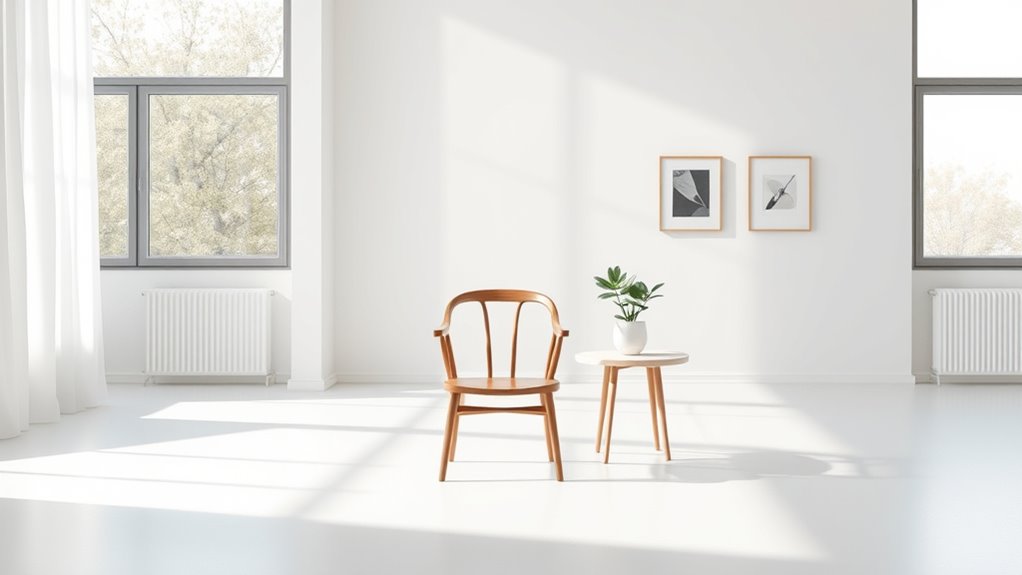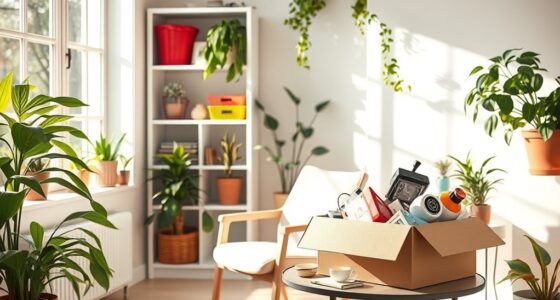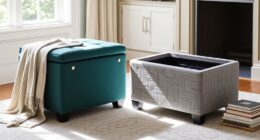To declutter your life, embrace the One In, Two Out rule. For every new item you get, remove two from the same category. This simple strategy promotes mindful consumption and helps you form lasting habits. By evaluating emotional attachments, you'll find it easier to let go of unnecessary items. Plus, a clutter-free space can enhance your mood and overall well-being. Stick around to discover more tips for achieving and maintaining a clean environment.
Key Takeaways
- Apply the One In, Two Out rule to remove two items for every new one you bring in, promoting mindful consumption.
- Set clear, specific goals for decluttering to enhance motivation and focus on desired outcomes.
- Break decluttering tasks into smaller, manageable chunks to prevent feeling overwhelmed and build momentum.
- Evaluate emotional attachments to belongings, prioritizing current needs over past memories to facilitate the process.
- Regularly implement daily tidying habits and reevaluate possessions to maintain a clutter-free environment long-term.
Understanding the One In, Two Out Rule
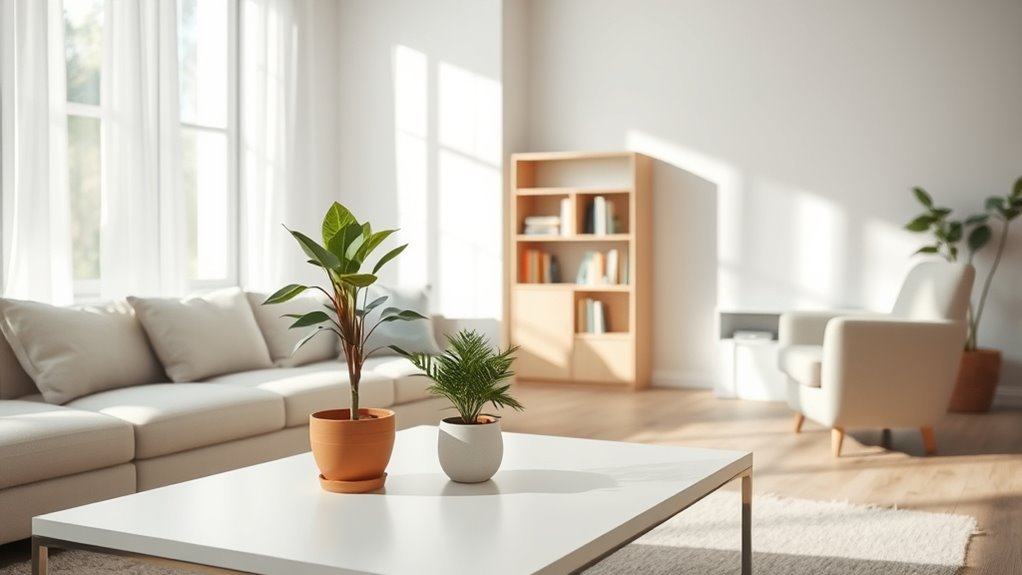
While decluttering can feel overwhelming, understanding the One In, Two Out rule can simplify the process. This rule means that for every new item you bring into your home, you remove two items from the same category. By implementing this approach, you'll aggressively cut down on clutter and maintain organized spaces. Start by assessing what you own, categorizing items like clothing or kitchen gadgets to streamline the process. This principle encourages mindful consumption, prompting you to think carefully about new purchases and embrace sustainable habits that enhance overall well-being. Although this rule requires discipline and may challenge your emotional attachments, it ultimately promotes sustainability and financial savings.
With commitment, you'll enjoy a clutter-free environment that enhances your everyday life.
The Importance of Setting Clear Goals
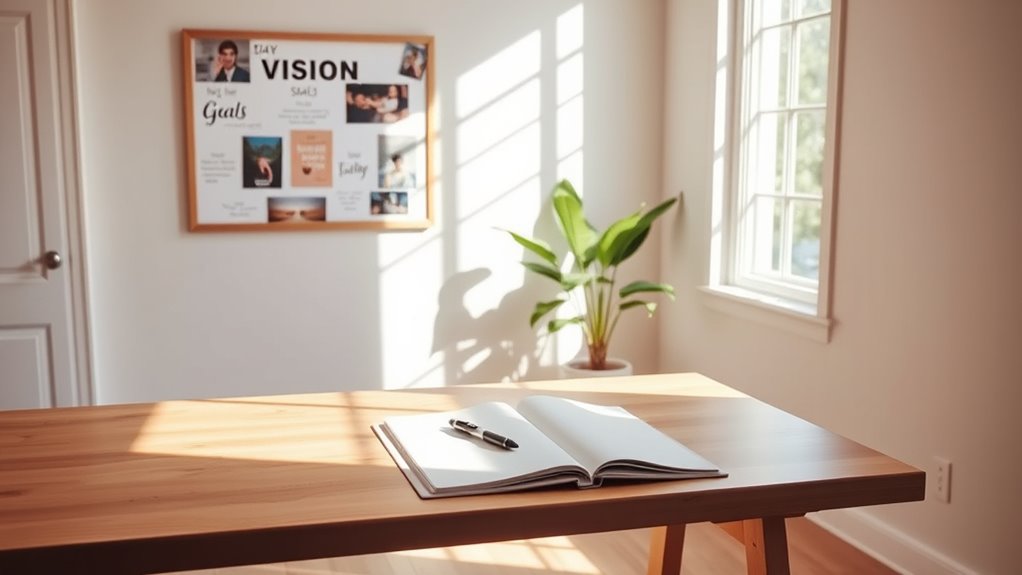
Implementing the One In, Two Out rule can set the stage for more significant changes in your life, particularly when it comes to setting clear goals.
Clear goals give you direction and purpose, helping you focus on what truly matters. By establishing specific and measurable objectives, you'll increase your motivation and enhance your focus. SMART goals encourage clarity and commitment, making it easier to track your progress and achieve desired results. Additionally, understanding the Vortex energy can further align your goals with your true desires, enhancing your overall alignment and emotional well-being.
This clarity aids in making effective decisions and boosts your productivity by breaking tasks into manageable steps. Moreover, clear goals improve your time management, ensuring you prioritize tasks efficiently.
As you achieve these goals, you'll experience a sense of accomplishment, fostering personal growth and confidence. Embrace this strategy to transform your life and achieve your aspirations.
Overcoming Procrastination in Decluttering
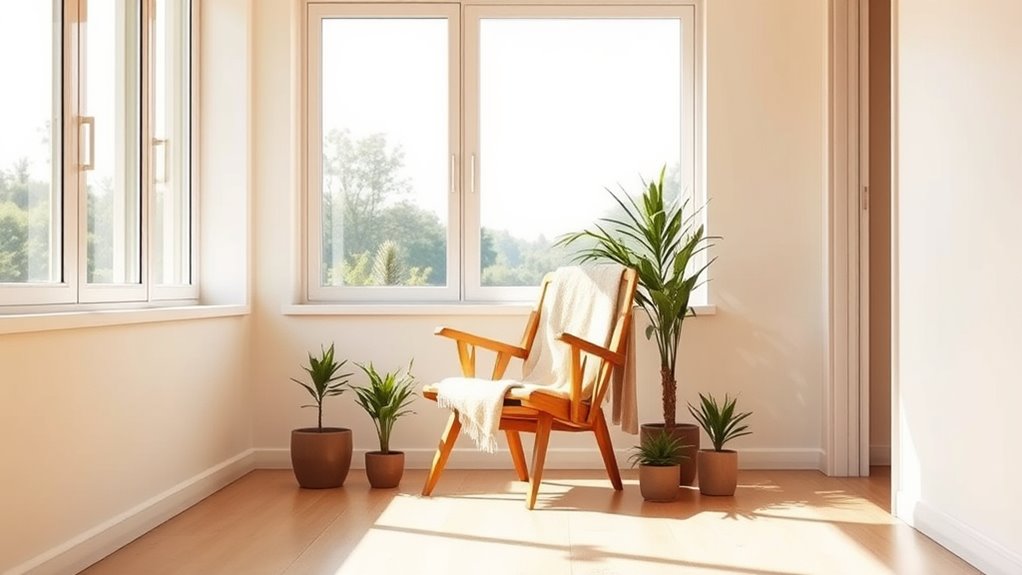
Procrastination often sneaks in when you face the daunting task of decluttering, leading to feelings of overwhelm and dread.
Procrastination can creep in when decluttering feels overwhelming, making the task seem even more daunting.
To combat this, break down your decluttering tasks into smaller, manageable chunks. Set a timer and use techniques like the Pomodoro method to maintain focus. Overcoming procrastination is a gradual process; practice techniques consistently to improve productivity.
Schedule specific decluttering sessions to create a sense of urgency. Start with easy tasks to build momentum and tackle the most cluttered areas first.
Visualize the benefits of a decluttered space to motivate yourself. Remember, it's okay not to aim for perfection; just take those first steps.
Utilizing Physical Sorting Tools Effectively
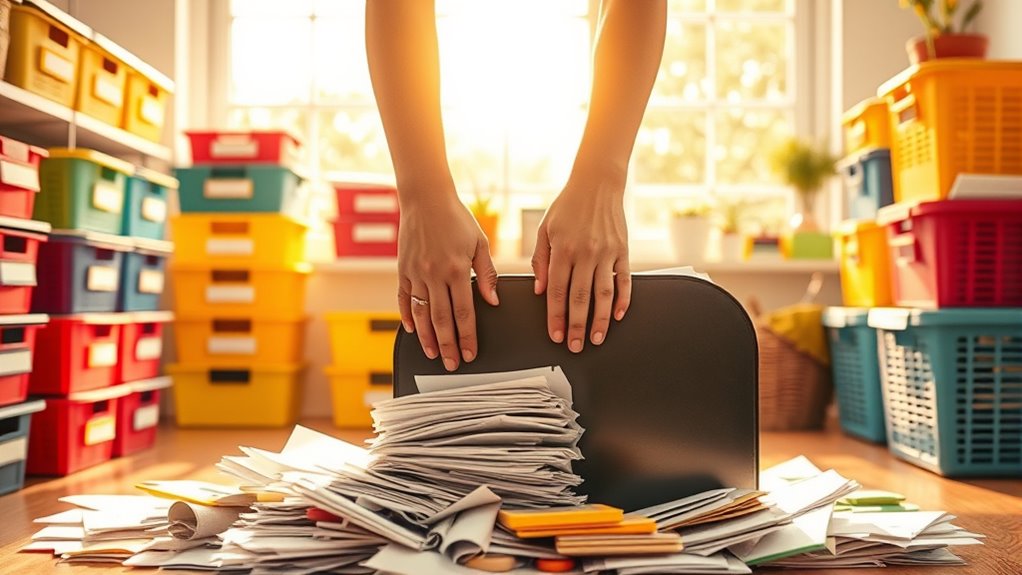
After overcoming the initial hurdle of procrastination, it's time to focus on the tools that will help you sort through your clutter effectively.
Start by gathering essential decluttering tools like black trash bags, labels, and markers. Use flexible laundry baskets and bins to hold your sorting materials. Color coding your boxes can enhance visual organization, making it easier to categorize items. A decluttering kit helps streamline the process and keeps you motivated. Additionally, consider utilizing vertical storage solutions to maximize your space as you sort.
For small items, towels can serve as temporary sorting surfaces. Set up a dedicated, spacious sorting area close to your workspace to maintain workflow. Keep your decluttering kit centralized for easy access to supplies.
The Focus on What You Keep
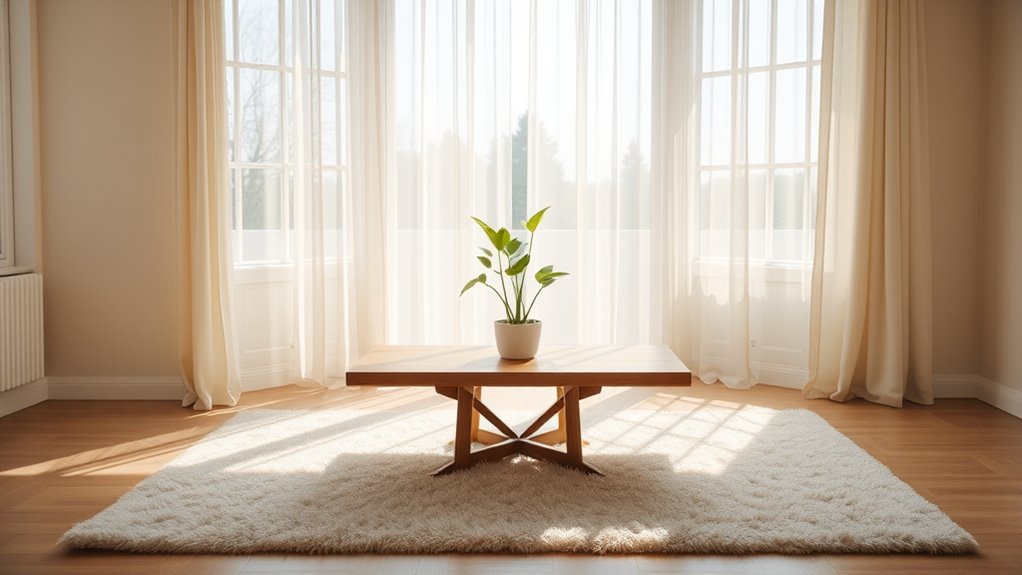
When tackling clutter, many find that shifting focus to what they choose to keep can transform the decluttering experience. This approach encourages you to evaluate each item based on its utility, necessity, or emotional value.
By concentrating on what sparks joy or serves a purpose, you minimize guilt and stress tied to letting go. You create a clearer vision for your space, enhancing personal satisfaction and well-being. This positive perspective on decluttering reduces stress associated with the decluttering process, allowing for a more enjoyable experience.
This mindset shift fosters self-awareness about your values and priorities, making decision-making more efficient. Regularly reviewing what you keep ensures it aligns with your current needs.
Ultimately, this positive focus contributes to a clutter-free environment, promoting long-term simplicity and contentment in your life.
Establishing Regular Decluttering Sessions
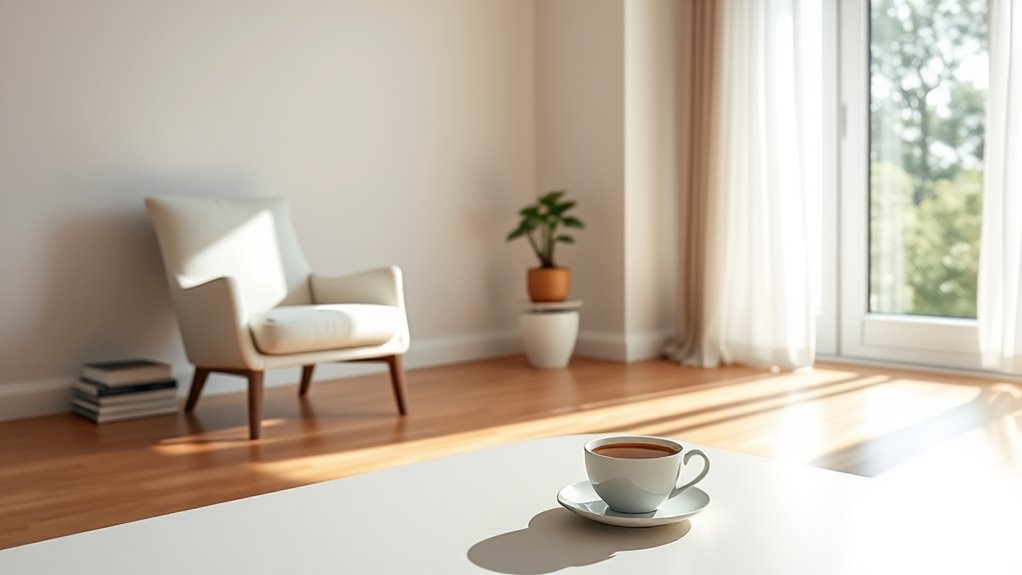
Establishing regular decluttering sessions can significantly enhance your living space and overall well-being. By setting aside specific times each week for decluttering, you create a consistent routine that maintains a clutter-free environment and reduces stress. Additionally, effective relaxation techniques can be utilized during these sessions to help you remain calm and focused.
Incorporate small daily tasks; even a few minutes can lead to major long-term results. Regularly review your belongings and adjust your priorities as needed, staying flexible to accommodate changes in your life.
Start small to make the process manageable, utilizing methods like the Four-Box Method for efficient organization. With a clutter-free space, you'll enjoy improved productivity, enhanced creativity, and better health. A clean, clutter-free home contributes to better physical health and mental state, further supporting your journey towards a more organized life.
Ultimately, these sessions will give you more time for enjoyable activities, enriching your life.
Emotional Attachment and Letting Go
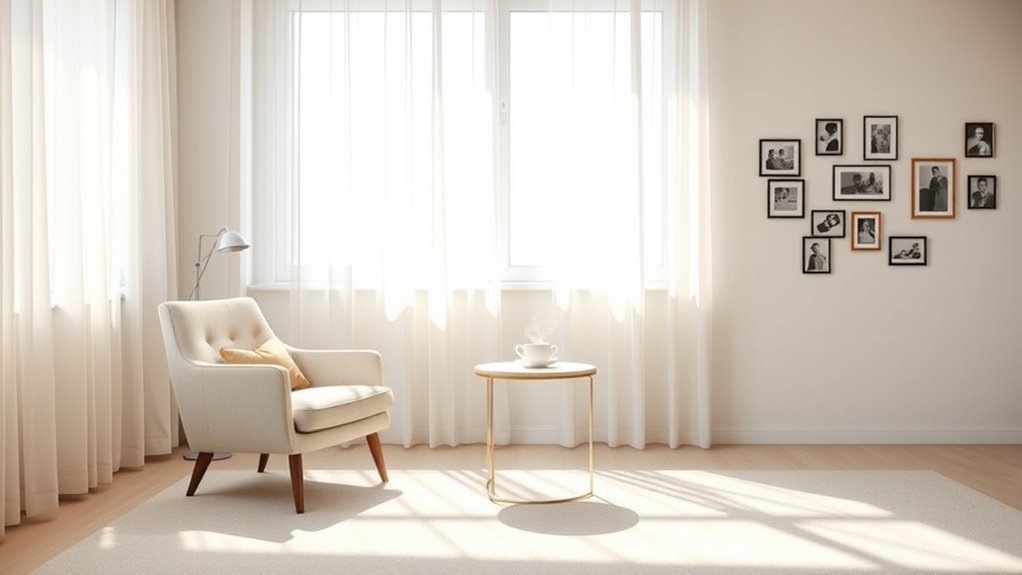
How can you start letting go of items that hold emotional weight?
Begin by evaluating your emotional ties. Ask yourself if keeping an item brings you joy or only distress. It's common for sentimental items to evoke guilt or nostalgia, complicating your decisions. To ease this process, consider preserving memories through photos or notes instead of keeping the physical object. Approach each item mindfully, focusing on your current needs rather than past emotions. Remember, physical clutter serves as a constant reminder of unfinished tasks, which can complicate your ability to let go. Creating a home that feels calm and functional can help alleviate the emotional burden of decluttering.
Practice self-compassion; decluttering can stir up emotions, and that's okay.
Creating Lasting Organizational Habits
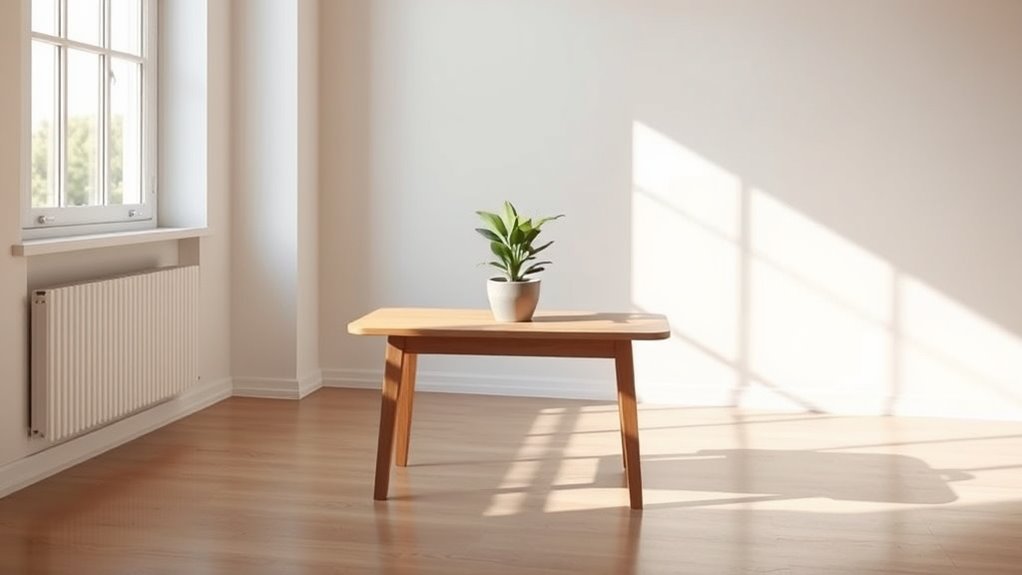
Letting go of emotional items can be liberating, opening the door to a more organized life. To create lasting organizational habits, focus on the cue-routine-reward loop. Set clear cues for tasks, like keeping a planner visible, and establish simple routines that are easy to follow. When you complete a task, reward yourself immediately to reinforce the behavior. Leaders must design processes that incorporate effective cues to promote habit retention.
Incorporating emotional intelligence into your routines can enhance your relationships and decision-making as you declutter your life. Use to-do lists to prioritize your tasks and avoid procrastination. Habit stacking works too; link new habits to existing routines. Start small and gradually build up. Celebrate your progress, no matter how small, to keep motivation high. By consistently executing these strategies, you'll develop organizational habits that stick, transforming your space and mindset.
The Psychological Benefits of Decluttering

Decluttering your space can lead to significant psychological benefits, transforming not just your environment but also your mindset.
By reducing clutter, you lower cortisol levels, which helps alleviate stress and anxiety. A tidy space minimizes visual distractions, allowing you to focus better and be more productive. Clutter negatively impacts subjective well-being, which emphasizes the importance of maintaining an organized environment for your mental health. Additionally, it encourages mindfulness, fostering a deeper connection with surroundings.
You'll feel a sense of accomplishment that boosts your mood and enhances your overall well-being. This process empowers you, fostering a sense of control over your environment and encouraging gratitude for what you truly value.
Additionally, a clutter-free home can improve sleep quality and even strengthen relationships by reducing tensions. Furthermore, it creates a sense of accomplishment and control that enhances emotional well-being.
Ultimately, decluttering supports mindfulness and self-care, paving the way for a more peaceful, intentional life.
Maintaining a Clutter-Free Environment Long-Term
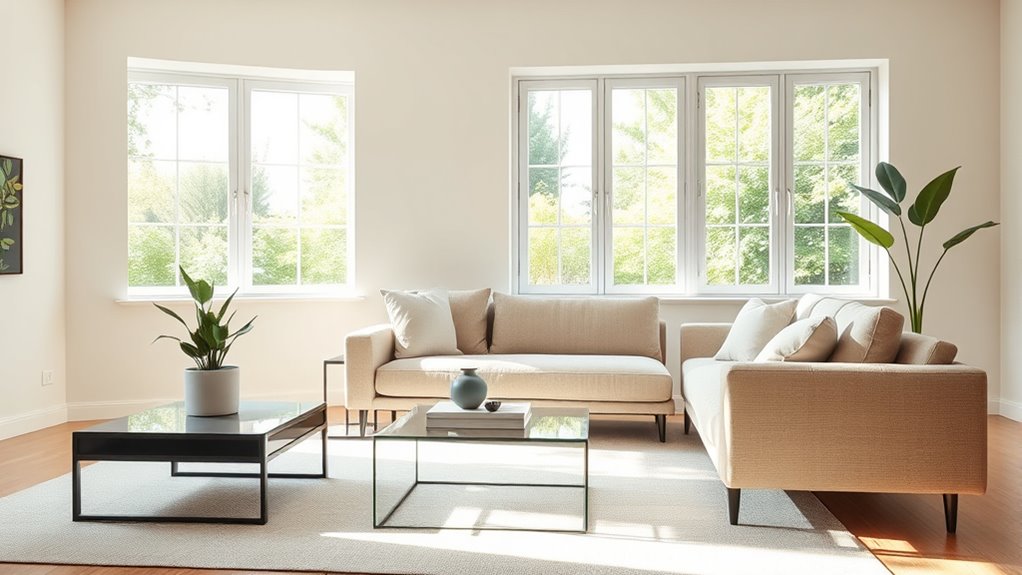
A clutter-free environment doesn't just happen overnight; it requires ongoing effort and commitment. To maintain this space, schedule regular decluttering sessions to keep unnecessary items in check. Sort belongings into categories like "Keep," "Donate," and "Discard" to streamline the process. Let go of items that no longer serve a purpose or spark joy. Involve family members by assigning tasks, making it a collective effort. Set clear goals for specific areas to stay focused and motivated. Use storage solutions like bins and baskets to keep things organized. Implement daily tidying habits, and remember the "One in, One out" rule to prevent clutter buildup. Regularly reevaluate your belongings to ensure your environment remains clutter-free long-term. A clutter-free environment promotes better mental and emotional well-being, making it essential to prioritize organization.
Frequently Asked Questions
Can I Modify the One In, Two Out Rule?
Did you know that the average American home contains around 300,000 items?
You can definitely modify the one in, two out rule to suit your needs. Consider adjusting it to different categories, like clothes or kitchen gadgets.
Focus on quality over quantity, allowing for exceptions when necessary. This flexibility helps you maintain a clutter-free space while encouraging mindful consumption.
Regularly review your approach to ensure it remains effective as your lifestyle changes.
How Do I Deal With Family Members Resistant to Decluttering?
Dealing with family members resistant to decluttering can be challenging. Start by leading by example; show them the benefits of an organized space.
Involve them in small, manageable tasks to avoid overwhelming them. Use positive communication, focusing on the advantages rather than criticizing their habits.
Be open to compromise and consider neutral spaces for decluttering.
Lastly, celebrate small achievements together to encourage continued participation and foster a supportive environment.
What if I Have Sentimental Items I Can't Let Go?
Studies show that 60% of people struggle with parting from sentimental items.
If you find it hard to let go, start by identifying what truly matters. Document their stories to shift focus from the object to the memory.
Set boundaries on how much you keep, and consider allowing each item a final purpose before saying goodbye.
How Can I Stay Motivated During Long Decluttering Sessions?
To stay motivated during long decluttering sessions, break your tasks into smaller, manageable steps.
Set clear goals for each session and use timers to keep you focused.
Take regular breaks to recharge, and don't forget to celebrate small wins along the way.
Visualize the benefits of a clutter-free space to boost your motivation.
Make it enjoyable by listening to music or involving friends, turning the process into a rewarding experience.
What Are the Best Apps for Tracking Decluttering Progress?
If you're looking for the ultimate decluttering sidekick, you're in for a treat!
Apps like Tody and Sweepy turn cleaning into a game, making it feel like a thrilling adventure.
ByeBye helps you track your belongings effortlessly, while Clean My House sends you gentle reminders to keep you on track.
For selling, Decluttr and Offerup make it super easy to turn clutter into cash, so you can declutter with style and efficiency!
Conclusion
By embracing the One In, Two Out rule, you're not just decluttering your space; you're transforming your mindset. Did you know that studies show a clean, organized environment can boost productivity by up to 30%? Imagine what you could achieve with that extra focus! As you let go of the unnecessary, you'll create lasting habits that keep your space—and mind—clear. Start today, and watch how a little decluttering can lead to big changes in your life!
